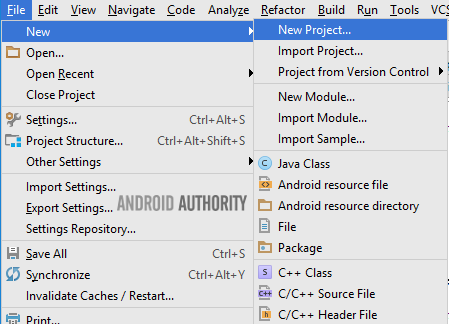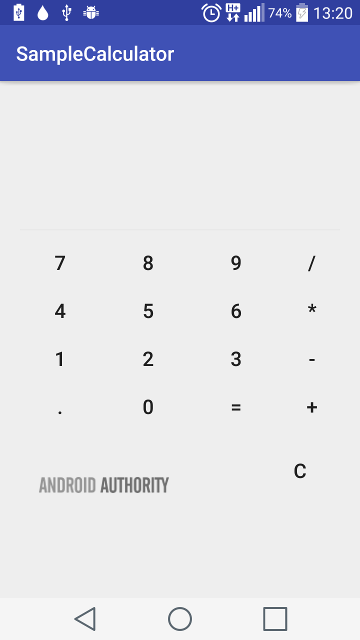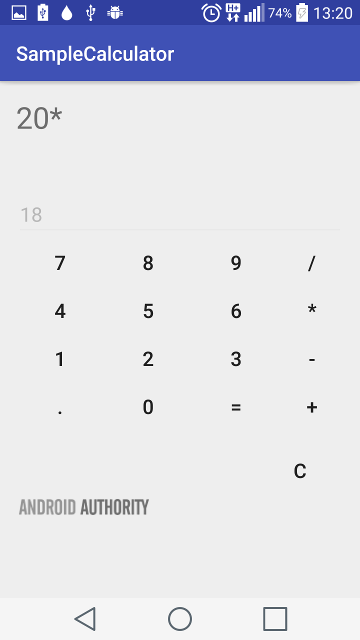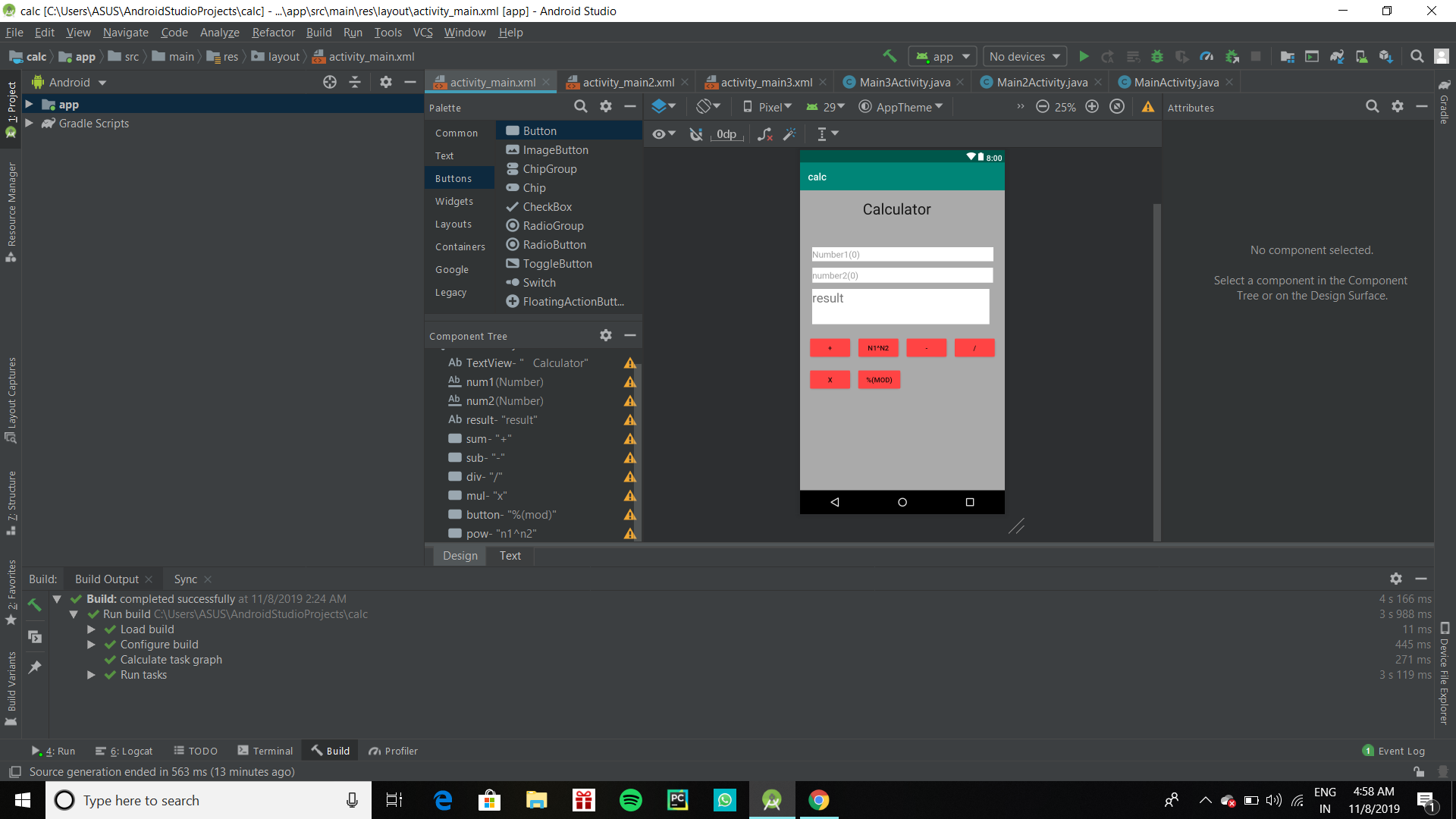калькулятор android studio код
В этом руководстве мы расскажем, как создать калькулятор на Java для Android. Если вы новичок в программировании и никогда раньше не создавали приложения, ознакомьтесь с нашим предыдущим руководством по написанию первого приложения для Android:
Создание проекта
Первое, что нужно сделать — это создать в Android Studio новый проект: Start a new Android Studio project или File — New — New Project :
Для этого руководства мы выбрали в панели « Add an Activity to Mobile » опцию « EmptyActivity », для « MainActivity » мы оставили имя по умолчанию – « Activity ». На этом этапе структура должна выглядеть, как показано на рисунке ниже. У вас есть MainActivity внутри пакета проекта и файл activity_main.xml в папке layout :
Включение привязки данных в проекте
Разработка макета калькулятора
Как научиться создавать приложения для Андроид? Читайте наше руководство дальше.
Общие принципы создания виджетов макета
В приложении калькулятора есть четыре основных элемента:
RelativeLayout — определяет, как другие элементы будут укладываться или отображаться на экране. RelativeLayout используется для позиционирования дочерних элементов по отношению друг к другу или к самим себе.
TextView — элемент используется для отображения текста. Пользователи не должны взаимодействовать с этим элементом. С помощью TextView отображается результат вычислений.
Button — реагирует на клики пользователя. При создании простого приложения для Андроид мы используем кнопки для цифр и операторов действий в калькуляторе.
Создание макета калькулятора
Код макета калькулятора объемный. Это связано с тем, что мы должны явно определять и тщательно позиционировать каждую из кнопок интерфейса. Ниже представлен фрагмент сокращенной версии файла макета activity_main :
Внутренние компоненты калькулятора
Затем мы используем класс DecimalFormat для форматирования результата. Конструктор десятичного формата позволяет отображать до десяти знаков после запятой.
Обработка нажатий на цифры
Обработка кликов по кнопкам операторов
Поздравляю! Мы завершили создание простого калькулятора. Теперь вы сможете создать приложение для Андроид сами.
Заключение
Если вы запустите и протестируете данное приложение, то увидите некоторые моменты, которые можно улучшить: 1) возможность нажимать на кнопку оператора, когда editText очищен ( т. е. без необходимости ввода первой цифры ), 2) возможность продолжать вычисления после нажатия кнопки « Равно ».
Пожалуйста, опубликуйте свои отзывы по текущей теме статьи. За комментарии, подписки, лайки, дизлайки, отклики низкий вам поклон!
Build a Simple Android Calculator App in 5 Steps – Full code tutorial and explanation
What will you learn?
Note: Find the full code of the android calculator project towards the end of the post. Read the entire post for further clarification and explanations.
Building the interface of the simple calculator in Android
As with all applications, we should always start by creating the interface. For the android calculator app, we require the following elements.
That’s it. We use the textView to show users the numbers they have written and also to display the result of the calculations we are going to do.
Each of the numbers will have a different button, from 0-9 and we will have four additional buttons for addition, subtraction, multiplication and division. Other than this, we require a button to calculate the operation, a button for decimals, and a button to clear the display.
Requirements
Here’s a screenshot of what the code at the bottom would look like if you were to paste it in your activity_main.xml file.
Coding the Functionality of our simple calculator
Step 1: Creating objects for our elements
In your Java file, which is almost always MainActivity.java by default, head on over to the MainActivity extends AppCompatActivity class. Inside that, create objects for all of your 15+ buttons and an object for your EditText. If you are unsure of how to do that, then copy and paste the following code. If you are uncertain of where to post this code, refer to the complete code tutorial by scrolling to the bottom.
Next, we will need two float values to store the first number and second number. We use float instead of integers because integers only hold whole numbers while float can hold decimal numbers too.
And finally, we need four boolean variables to check what operation is going on. A boolean variable returns only two variables — a true and a false. We check which button is pressed and use this boolean variable to perform the corresponding function.
Step 2: Fetching values from the elements into the working of our app
Inside the onCreate function, we will fetch all values and assign them to our objects. We do this by the following code
Here, we are fetching the value of ‘btn_0’, which is the ID of our button zero, and storing it in the object ‘btn_0’ that we created earlier. Though they are named the same, Android Studio can identify the correct one. But if it gets confusing for you, feel free to give either one of them any other names.
We do the same with our EditText.
Step 3: Changing the EditText value by pressing the buttons.
We use OnClickListener for this part of the program. This is what happens when you push one. The editText, first already fetches the value that it is already displaying, null in this case, and then adds 1 to it. If we don’t fetch the existing value, then it will become impossible to enter multiple digit numbers.
Do this on repeat mode for each of the numbers as well as the decimal. These are input buttons, and the code is the same for all. But remember to replace “1” with the appropriate value of the button you are adding to it.
Step 4: The functional buttons
Here’s the code we are using for multiplication.
We are using our first float value ‘Value1’ here. We use the simple function getText() to do that. Here since we pressed the multiplication button, we set its boolean equivalent variable to true. You will see how this is helpful in the ‘calculate’ button coding.
Now since after we press the multiplication button, we have to input another number. We set EditText to display the null value.
We do the same process for Addition, Subtraction, and Division. The only difference is that their respective boolean values will be set to True.
Step 5: Calculating, the actual functionality
Here’s the code of what happens when you or someone else presses the ‘=’ button after inputting another integer.
If you are a quick reader and just copy-pasting code, then the above code is not the complete code, it only checks for subtraction.
Next, we execute an if-condition to check whether our four boolean values are true and then run its subsequent code. In the above example, we are executing only the if condition for subtraction. For the full code, refer to the code below.
The main operation is happening in the ‘ed1.setText(Value1 – Value2 + “”);’ line. For other functions, replace the – sign with others.
Now write the code for all functions and run the app. If you do the first operation
You’ll get the right answer as
But there are still a lot of flaws in this app. And that’s why this is a basic version of the app and not an advanced debugged version.
Flaws of this android calculator app that are not covered in this post
Check out some more of our tutorials on Android.
Full Code for the User Interface for Android Simple Calculator App
Full Code Tutorial for the Functionality of Android Calculator App
Remember to change your package name to what you are using!
Asem has a Bachelors Degree in Computer Science.
Back to course page
2 thoughts on “ Build a Simple Android Calculator App in 5 Steps – Full code tutorial and explanation ”
tҺe website іѕ really good, I really like your website!
bhai please iski apk aap send kar do…….whatsapp-9373115274
Leave a Reply Cancel reply
This site uses Akismet to reduce spam. Learn how your comment data is processed.
How to build a simple calculator app – full tutorial with code
Continuing the Android Authority tradition of building simple apps (see how to build an image gallery app and how to create an SMS app), we are going to build a simple but functional calculator app. If you’re new to programming and have never built an app before, you should check out our previous tutorial on writing your first Android app. This tutorial assumes that you have at least, some basic experience writing Android apps.
Much like developing any non-trivial program, there is more than one way to do it, and if you get ten different programmers, you might get ten different ways of writing a calculator (unless they all happen to be Android Authority readers *wink*). The complete source for the calculator app written below is available on github for use, reuse and modification as much as you like.
Creating the project
For this calculator tutorial, we selected the EmptyActivity option on the “Add an Activity to Mobile” screen, and left the Activity name as the default MainActivity. At this point, your layout hierarchy should look like the image below. You have a MainActivity within your project package, and an activity_main.xml file in the layout directory.
Enable data binding in your project
For our sample calculator, we will setup our project to use data binding. Using data binding in this app simply helps us refer to our widgets (Buttons, EditText and TextView) directly, rather than finding them with findViewById() methods. To enable data binding, you must add the following line to your app build.gradle file.
Designing the Calculator layout
To enable data binding in our activity_main.xml file requires one last change. Wrap the generated root tag (in our case it was a RelativeLayout) within a layout tag, making the layout tag the new root tag.
The layout tag is what alerts the build system that this layout file intends to use data binding. The build system then generates a Binding class automatically for this layout file. Since the target xml file is named activity_main.xml, the build system will generate a class called ActivityMainBinding, which you can reference in your app like any other Java class. The class name is generated from the layout file name by capitalizing the first letter of each word after an underscore, removing all underscores, and adding ‘Binding’ to the name.
At this point, switch to your MainActivity.java file. Create a private ActivityMainBinding instance within your class, and in the onCreate() method, delete the setContentView() line and replace with the DataBindingUtil.setContentView() line in the code snippet below.
Understanding the layout widgets
There are four main items in our calculator app. These are:
Building the Calculator layout
The calculator layout is a bit long. This is due to the fact that we have to explicitly define, and meticulously position, each of the buttons in the calculator. The snippet below is a condensed version of the activity_main layout file
Calculator internals
Our calculator has two values, valueOne and valueTwo. These values hold the numbers to be operated on. Both values are of type double, so they can hold numbers with and without decimals. We set valueOne to the special Double value NaN (not a number) for reasons that will be clearer below.
This simple calculator can only perform operations of either addition, subtraction, multiplication or division. So we define four static chars to represent these operations, and a CURRENT_ACTION variable, which holds the next operation we intend to perform.
Finally, we use the DecimalFormat class to format the output of our calculator. The decimal format constructor permits displaying up to ten decimal places.
Handling button clicks (numbers)
Whenever the user clicks a number (or dot), we simply want to add that number to the editText. The code sample below shows how we accomplish this for number zero (0).
Handling button clicks (operators)
Handling clicks on operators is a little different. We would like to perform any pending computations first. So we define a computeCalculation method. Within computeCalculation, if valueOne is a valid number, we read valueTwo from the editText, and perform the current queued operation. On the other hand, if valueOne is NaN, valueOne assigned the number in the editText.
For every operator, we call computeCalculation() first, then set CURRENT_ACTION to the selected operator, while for the equals ‘=’ operator, we call computeCalculation(), then clear the contents of both valueOne and CURRENT_ACTION.
Congratulations! You have completed your simple calculator Android app.
Finally
If you run and use the above app, you will notice some possible areas of improvements, such as 1) click an operator when the editText is clear (i.e. without entering a number first), 2) allow the user continue calculating after clicking the equals button.
As always, the complete source is available on github, and you are free (nay encouraged) to modify, and use, to your heart’s content. Hola in the comments if you found this useful, and/or want to recommend an app for a future tutorial.
How to build a simple Calculator app using Android Studio?
Create a simple calculator which can perform basic arithmetic operations like addition, subtraction, multiplication, or division depending upon the user input. A sample video is given below to get an idea about what we are going to do in this article. Note that we are going to implement this project using the Java language.
Step by Step Implementation
Step 1: Create a New Project
To create a new project in Android Studio please refer to How to Create/Start a New Project in Android Studio. Note that select Java as the programming language.
Step 2: Working with the activity_main.xml file
Navigate to the app > res > layout > activity_main.xml and add the below code to that file. Below is the code for the activity_main.xml file.
After using this code the UI will be like:
Step 3: Working with the MainActivity.java file
Open the MainActivity.java file there within the class, make a method named doSum(View v). In this method, first of all, we have to link two EditText with variables so that we can use them for our input. So link those edit box with variables we have written
Here num1 is id for textbox and we are just giving a variable name ‘e1’ to text box with id ‘num1’. Similarly, we have to use the same statement for the second textbox with the variable name ‘e2’. For the third text box, we have used
Here we have used TextView because we only have to display text avoiding it being user-changeable. Now we have to input numbers in form of string using the getText() function. The input statement will be
Here s11 stores the number entered in textbox 1.We have to do the same with another Textbox(e2). Now store the number in int form and apply addition. store the added value in another variable. To display stored in sum we have to use setText() as follows:
Building a Simple Calculator in Kotlin Using Android Studio
In this tutorial, we will learn how to build a simple calculator in Kotlin using Android Studio.
Description
In this tutorial, we will develop a “ 10-key” calculator on Android Studio using Kotlin. The buttons included should be:
Now we know how our calculator should look and work like, let’s get started. I will try to provide all the essential steps, in order for you to understand.
Step 1: Create an “Empty Activity” on Android Studio.
Let us create a new project. Since our calculator comprises only one activity (we need only one activity Kotlin file and one XML layout file) we need to select an “ empty activity”. This can be done as shown below:
New → New Project → Empty Activity
After you create an empty activity, configure your projects such as name, package name, location, language, and API level. Follow the screenshot below to configure your project for consistency. Make sure you select the language as Kotlin (obviously I’m coding in Kotlin). And then click on finish, then your project would be loaded.
To know more about the API level you can refer to google’s official documentation given below, it’s not mandatory to select API 15 as shown in the above screenshot. Just select it for consistency for the tutorial’s sake.
Codenames, Tags, and Build Numbers | Android Open Source Project
Android development releases are organized into families with alphabetical codenames that are inspired by tasty treats…
Step 2: Adding colors to the colors.xml file
As the name suggests in the color files, we can specify the colors for all the buttons of the calculator. The colors.xml file can be found in:
app →res →values →colors.xml
Step 3: Modifying the styles.xml file
The style file is used to define the format or the look for a UI. A style can be applied to an individual View (from within a layout file) or to an entire Activity or application (from within the manifest file).
The styles.xml can be found in
app →res →values →styles.xml
All the above are just style properties for the calculator defined in the styles.xml file. To brief out
NumberButtonStyle: Keys → 1, 2, 3, 4, 5, 6, 7, 8, 9, 0
Step 4: Configuring the “activity_main.xml” file
This is the main layout file here you need not use the UI editor, rather you can code the entire layout using XML. Here we can use the text view layout rather than buttons for the keys. I’m placing all the text view inside a linear layout. It is a mechanical process because of multiple text views. So just follow along with me right now.
Step 5: Placing the expression builder library inside the Gradle.
I have used the Expression Builder library to calculate the expressions. With the help of a GitHub repository, I learned how to do this. I was struggling to use the equals button for generating the result. So now just place the expression builder library inside the Gradle.
app →Gradle Scripts→build.gradle
Step 6: Actual Kotlin coding for the calculator
First, I’m appending 1, 2, 3,…..0 when the users press the keys to the text view, respectively. To do this, I have created a function called evaluateExpression() which does the appending job to the text view. Then in the Equals function, I am using the Expression Builder library and calling its method Expression Builder to do the calculations. The code is pretty much self-explanatory. The main_activity.kt can be found in:
app → java →com.example.myapplicationcalculator →MainActivity.kt
In my case, the package name is com.example.myapplicationcalculator, it might vary in your case.
Step 7: Run the app using the emulator
This is the last step, now that you have written all the Kotlin code, XML file now let’s test the result. To do this, we can use the androids built-in emulator. Click the Green button which looks like a play button at the top right side or just press Shift + F10. If you don’t know how to configure and use the android built-in emulator. Please check the video down below:
Alternatively, If you are having a problem using the emulator or if your laptop is heating a lot. Don’t worry there is always a second option. Use Genymotion as an external emulator. You can video how to set up Genymotion below:
Now all set and done when you run the emulator you will get a beautiful simple calculator if not then double-check your code.
User Interaction
The above table 1 shows the buttons and functions of the basic calculator. These operations resemble the basic calculator that everybody knows of these days. This calculator displays up to 18 characters on the screen for example (1/3 = 0.3333333333333333). This calculator has good user experience and design it looks and feels slightly like advanced calculators that we often use in our android phones. In fact, I intended to design it based on my current android smartphone.
Known Issues and Limitations
By using this calculator, we cannot use the keyboard shortcuts to enter the inputs. We can only use the buttons provided in the calculator itself to enter the inputs. This is not a big thing to worry about because this is an android application. Everybody runs this application on their smartphone you don’t need a keyboard to enter the numbers.
Also, this calculator does not provide any error messages if someone tries to divide by 0. If someone enters two operations simultaneously, then the calculator does not display any error messages. For example, by entering the expression 5**+9, the calculator does not freeze or crash, rather it waits for the user to change the operations and make it a valid mathematical expression.
Other than these two limitations, the application meets all the criteria that are listed in the description section above. I have used the text view layout as buttons because I found this as an easy way of organizing buttons next to one another. I had some problems while I was manually laying the buttons next to another. Every-time when I executed the application using an emulator the buttons were scattered all across the screen, even though I constrained the layout. With the help of the text view layout, I could solve this issue.
Hence we have knowingly or unknowingly built a beautiful simple calculator using Kotlin on Android Studio. This is just a simple calculator we can add some more features also build a scientific one. But this is more than enough for a good start to get hands-on Kotlin and Android Studio Coding. I would recommend you guys to type the code rather than copy-pasting, sometimes when you copy-paste you end up getting errors because of package mismatch. Everybody has different packages in the android studio, so type and learn. If you guys have any doubts regarding this tutorial, then post a response or comment down below. I will respond quickly. Until then see you, Good Bye.



















